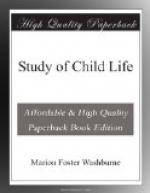Now is supremely the time for a study of the Bible. Interesting as a Divine Story Book to the young children, it becomes the Book of Life to these older ones. In teaching it at home, a few simple rules need to be borne in mind. The first is that the Bible must be thought of not as a series of disconnected texts and thoughts, but as a connected whole. The division of King James’ Bible into verses and chapters is but poorly adapted to this purpose. The illogical, strange character of the paragraphing, as measured by the standards of modern English, is apparent at a glance, for often a verse will end in the middle of a sentence, and the sentence be concluded in the next verse. The chapters in the same way often fail to finish the subject with which they deal, and sometimes include several subjects. Therefore, the mother who undertakes to read the Bible to her children needs first to go through the lesson herself, and to decide what subject, not what chapter, she will take up that day. There is a reader’s edition of the Bible, and one called the “Children’s Bible,” both of which aim to leave out all repetition and references and to arrange the Bible narrative in a simple, consecutive order, nevertheless employing the beautiful Bible language. These editions might prove of considerable help to mothers who feel unequal to doing the work by themselves.
[Sidenote: Children’s Bible]
Second, comparable to this in importance is the reading of the Bible and talking about it in a perfectly ordinary tone of voice; for what you want is to make the Bible teachings live in to-day. You must not, therefore, suggest by your tone or manner that they belong to another day, and that they are, in some sense, to be shut out from common life and speech. This does not mean such common use of Biblical phrases in every day conversation as to cause it to grow into that form or irreverence known as cant, but it does mean simple usage of Bible thought, and the effort to fit it to the conditions of daily life. Such a habit in itself will force any family to discriminate as to what things in the Bible are living and eternal, and what things belong rightly to that far away time and place of which the Bible narrative treats, thus practicing both teacher and pupils—that is, both parents and children—in the art of finding the universal spirit of truth under all temporal disguises. Without this art the Bible is a closed book, even to the closest student.
[Sidenote: Making Lessons Real]
Again, every effort should be made to help the home Bible class to understand the period studied in that week’s lesson, and to this end secular literature and art should be freely called upon, not only such stories, for example, as “Ben Hur,” but other stories not necessarily religious, which deal with the same time and place; they are of great help in putting vividly before the children and parents the temporal setting of the eternal stories. Cannon Farrar’s “Life of Christ” is a very great help to the realization of the New Testament scenes, as is also Tissot’s “Pictorial Life of Christ.” In short every art should be made to deepen and clarify the conceptions roused by the study of the Bible.




